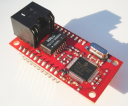Table of Contents
230 V Dimmer
The Netzer supports the direct connection of phase dimmers. So it is possible to control high voltage loads like bulbs via Ethernet resp. Intranet/Internet.
Be careful when experimenting with 230 V. There is danger to life!
A phase switching mechanism is described here that is for example built up by a thyristor. For this switching mechanism, the important feature of the thyristor is that in zero crossing it deletes from mains voltage itself, i.e. switches off.

The switching mechanism basically consists of zero-crossing detectors and a dimmer circuit.

Zero-crossing detector
IO0 is used as a zero-crossing detector for the 50 Hz network frequency. For this purpose, the pin is required to be configured as a digital input with an edge trigger switched on:

Zero crossings must be captured by an external circuit, creating a homopolar pulse during every zero crossing. For this purpose, for example an AC optocoupler such as SFH620 is suitable.
Dimmer circuit
A triggered pulse output of Netzer is dimmed. IO3 or SPI_INT are both suitable for this. It is hence possible to operate up to two dimmers in parallel.

This setting allows very granular gradations with a resolution of 200 ns. Since under mains voltage a half cycle is 10 ms and values between 100 (the is the smallest possible value in pulse operation and 50000 possible. Values comply with the time according to which the thyristor is powered. I.e. the larger the value, the less power will run at the output.



